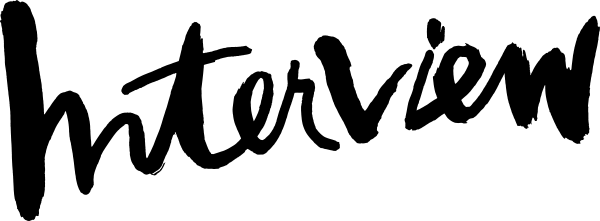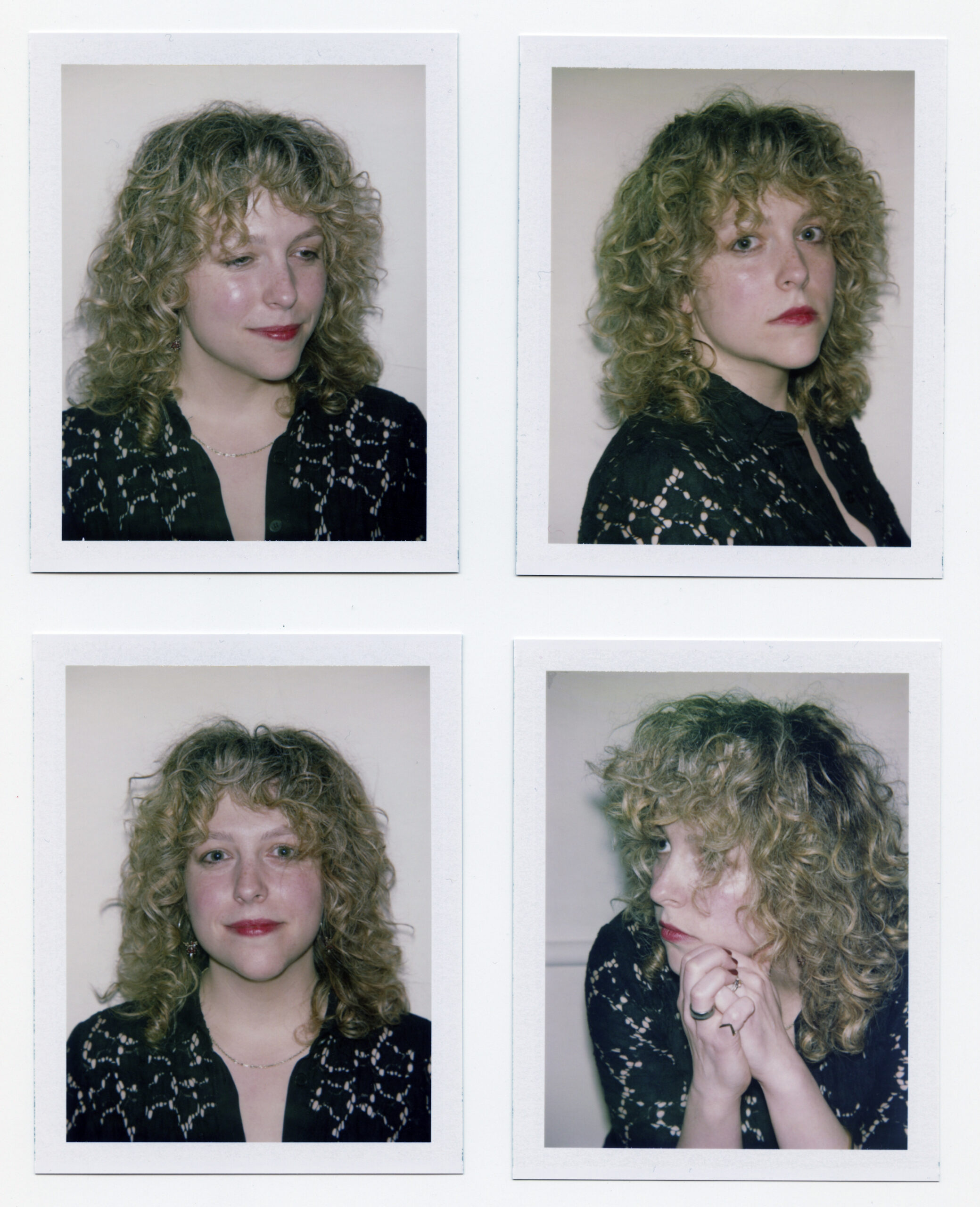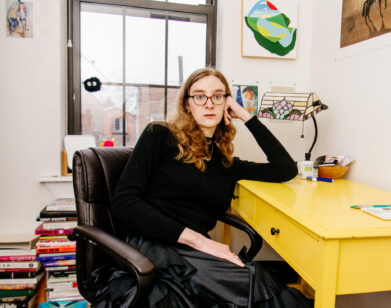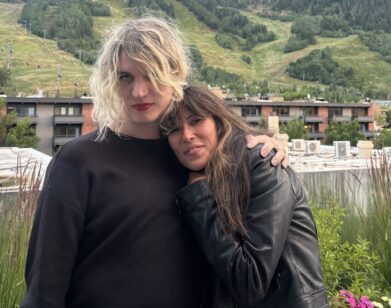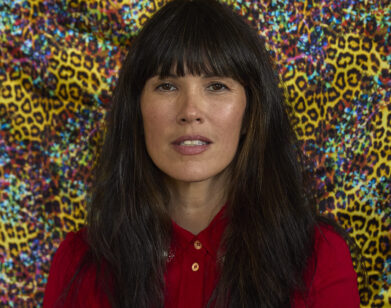IN SESSION
Hannah Zeavin Tells Us Why Psychoanalysis Is About More Than Just Daddy Issues
The first time I met Hannah Zeavin, founder of the psychoanalytic magazine Parapraxis, she told me I would make a good analyst. We were at dinner in Tribeca and she was editing a piece I’d written on the complicated history of conversion therapy. Parapraxis has attracted a wide range of politically-minded interlocutors like Jacqueline Rose and Joy James, disloyal daughters of the profession. Zeavin’s newest book, Mother Media: Hot and Cool Parenting in the Twenty-First Century, considers the history of motherhood and its intersection with technology such as baby monitors, the television screen, and children’s programming like Sesame Street. At times, the book reads like a cautionary tale, advising that readers remain suspicious of facile solutions to child-rearing. But it’s also a devoted work of scholarship that opens us up to the ambiguities of mapping motherhood onto inanimate objects. Parent, child, and screen, Zeavin finds, persist as an unruly threesome. Before the book’s publication, I talked to the author about the so-called iPad crisis, Noguchi-designed baby monitors, and whether or not we’re seeing a “return to Freud.”
———
GRACE BYRON: I know the answer to this question, but for people who don’t, how did you come to psychoanalysis?
HANNAH ZEAVIN: [laughs] Did I come to psychoanalysis or did psychoanalysis come to me?
BYRON: Literally.
ZEAVIN: My parents are analysts, so psychoanalysis was in the environment my entire life. They raised me at the adult end of the dinner table, and all of the avuncular figures by and large are analysts. I’m currently writing a book about the childhood of the children of analysts. No one was pointing at me and saying, “Oh, look at that pre-Oedipal Hannah,” but it really left its traces. Then I came to psychoanalysis again as a patient, in a moment of crisis when I really needed care, and then I came to it again critically with my first academic book, The Distance Cure: A History of Teletherapy (a small poetry book, Circa, came out when I was 17).
BYRON: Oh, wow.
ZEAVIN: Yeah, I came up as a poet. Then, I was studying cultural history and took this class where we had to read Mourning and Melancholia and it changed my life because of its deceptive simplicity. I never wanted to understand something so badly. Within a few years, I was getting a PhD in the history of psychoanalysis and more or less stopped writing poems.
BYRON: That was all before you were 20? I didn’t realize poetry was such a big part of your history.
ZEAVIN: It’s like, once a poet, always a poet, even if you try to kill it off. But I’m married to a poet. Most of my friends in the Bay Area are poets.
BYRON: Big poet area.
ZEAVIN: My parents made this hilarious error of a deal with me that I didn’t have curfew if I was at a poetry reading. So I went to the Poetry Project and they had events Monday, Wednesday, and Friday night.
BYRON: Big mistake. (Laughs) In some of the popular writing that you’ve done, you’ve talked about this return to Freud. I wonder how you see that now, especially now that Parapraxis has had a few years.
ZEAVIN: I have thought a lot about this. At this point, we have to say something like a “return to psychoanalysis” is happening. I always try to fight against it being just about daddy, because it’s not. It’s also Lacan—god forbid—and [Melanie] Klein and [Wilfred] Bion and Marion Milner and Tosquelles. Akshi Singh has a book out on Marion Milner this May, and there was an earlier book on Milner last year by David Russell. There’s been an art show at the American Folk Art Museum on Tosquelles and a new show by Perwana Nazif in Los Angeles on him and Francois Pain and a new booklet out on Semiotext(e), more and more translations. Of course, I do think that Parapraxis, which I edit with the most incredible people, also contributes. But there is an effervescence, absolutely.
BYRON: Yeah.
ZEAVIN: Even the way we’ve seen psychoanalysis creep in at other magazines has been incredible, and not just the question of a return to Freud. But what would it mean to actually take a return to psychoanalysis seriously? The field remains so violently conservative in its US mainstream iterations. The psychoanalysis I want to see in the world is still singing its minor chords, even as it has a really long, vibrant history that we’re constantly being asked to forget by mainstream psychoanalysis. It remains to be seen. That’s my ambivalence.
BYRON: Did you listen to the Ordinary Unhappiness episode about A Dangerous Method, the Cronenberg film?
ZEAVIN: No, I haven’t yet.
BYRON: I think that podcast does a really good job thinking about why people are currently finding psychoanalysis so sexy, and that episode was looking at this little blip of time when people were suddenly fascinated by Jung and Freud and the triangulation.
ZEAVIN: Ordinary Unhappiness is fantastic, in part because they’re getting folks who aren’t necessarily that hooked up into psychoanalytic discourse to think with them. Let’s add them to the litany of brilliant people doing this work.
BYRON: Turning towards the book, how would you explain motherhood as a form of media or mediation?
ZEAVIN: My second book, Mother Media, really comes out of work done towards the end of The Distance Cure, where I was thinking with Fanon and Melanie Klein, who don’t necessarily get thought of together. I went and read so much really bad mid-century psychiatry, psychoanalysis, and pediatrics. I began to notice that starting in about 1939, people who otherwise would have nothing to say to each other all began to say the same thing, which is that the mother redounded to essentially “a series of inputs into children who then yielded a series of outputs.” That was how a behaviorist would talk about it. The psychoanalyst talks about it in very similar terms, the “maternal matrix,” Erik Erikson’s popularization, though not his coinage. Everything redounds to mother, there is no outside. What she conveys to the child is everything. She is a medium, a matrix, a container. I identified that what they’re all saying was that the mother is a medium of care and that she alone is responsible for childhood development and outcomes.
Freud was not that interested in the mother, really. We all think of Freud as like, a mom obsessive, and that’s a false memory. There’s a lot of cultural misremembering of psychoanalysis, for better or for worse. Anyway, at the same time in the ’30s, media researchers, which was a new field at the time, began to think of media in terms of mothering. The example I always give is the harried mother at the airport. She’s just trying to keep her child quiet because we’ve been told children must be quiet in public and that’s hard for children. She’s shushing and she’s handing over the iPad exasperatedly. If you look around, you’ll see people reacting to the child, but also the way that the child is being soothed with the iPad. Mothers have been doing that since the beginning of optical toys in the late 1800s. There’s also a base assumption that a contamination is happening to childhood through media.
BYRON: Screen time is something you talk about in the book, though I don’t think you go fully into the current crisis of iPad screen time.
ZEAVIN: There’s a very different version of this book that would be about me and my son Malachai. I had to answer these questions for myself as I began to mother, but this is a cultural history of mother blame and media blame, and actually argues that they’re co-emergent. However, I started writing the book before I became a mother, and parts of my scholarly work were battle-tested by that experience. People say, “Sleep when the baby sleeps,” but I was writing when the baby slept. The book is actually more in conversation with my own childhood, and even before my childhood, because the book more or less concludes in the 1980s. The fifth chapter is a history of screen parking, and it’s looking at the earliest media research, like, “What are movies doing to children? Is it making them delinquent?” They’re hooking children up to what was probably called a jiggleometer to measure how restless they are after being exposed to cinema.
BYRON: Right.
ZEAVIN: I’m so allergic to the idea of advice. No one ever wants it. But at the same time, parents are often really desperate for advice. The book is about the impacts of taking it. We underestimate now how intensely central these experts were. Dr. Spock’s book, one of the bestselling books of all time in the United States, really shaped US mothering in ways that now would be like, “Are you an Emily Oster mom or are you a Dr. Becky mom?”
BYRON: And I guess there’s a few different panics that you bring up, a particularly striking one being the Lindbergh kidnapping. There’s something about the role that true crime plays in our ideas about motherhood.
ZEAVIN: I highly recommend Paula Fass’s book, Kidnapped: Child Abduction in America. She talks about the Lindbergh baby kidnapping there, which is a story of a very wealthy baby whose father is a Nazi pilot in the US. The baby goes missing from a mansion and the family turns on the domestic workers so intensely that their maid dies by suicide. She’s cleared the next day. The other, the nanny who discovers that the baby is missing, emigrates back to Scotland. I read this case both to think about “nanny panic” and the role of domestic laborers in the US family, but also how that class of worker becomes available for fascistic remediation in the form of a baby monitor. It was first put to use and designed and commissioned by the president of Zenith Radio Corporation who wanted to be able to, on his yacht, have his wife entertain with him down one end, play poker or whatever, refresh the drinks, while baby was sleeping down the other end of—let me say it again—the yacht.
BYRON: That’s crazy.
ZEAVIN: In the middle of the Great Depression. And they hired Noguchi to design it. It’s beautiful.
BYRON: Wow.
ZEAVIN: Eventually, we come to understand the baby monitor on the one hand and the nanny cam on the other, one for surveillance and one for care, but they’re the same technology. That’s one of the major thrusts of that first chapter.
BYRON: It’s like any of the other anxieties about the other. Also, I think a big part of the book is the role of race and motherhood, both using the work of Joy James, but also the Moynihan report. I thought that the chapter on prison was also very illustrative, and I had not heard about some of those experiments and programs before.
ZEAVIN: Totally. This is why in the first chapter I wanted to focus on domestic laborers, who are often not thought of as mothers themselves, but they are, and how it shapes the panics about family structures in the Postbellum period after Reconstruction. In the first chapter, I’m thinking with my colleague, Stephanie E. Rogers-Jones, and her book They Were Her Property, which is essential reading about how white women slave owners thought about chestfeeding. Wet nursing was, on the one hand, hyper-reliant on enslaved Black women’s reproductive labor, but on the other hand, they’re absolutely terrified that race could pass in that very milk. That’s an early example of mother as medium too, right?
BYRON: Right.
ZEAVIN: The chapter you’re talking about is chapter four, and I was really interested in René Spitz, a Viennese psychoanalyst. He did a lot of filmic work in the ’40s, including this very famous film that I showed at Light Industry a couple of years ago comparing orphanages with middle-class homes, but he also was doing all this work in a US prison. The prison is never identified in the literature. There’s great scholarship on Spitz, but it always bothered me that we didn’t know what prison it was, so I went and figured it out. The prison is Bedford in upstate New York, which has a fascinating and intense past. It has the longest extant mother-baby program in a prison. I got all the log books, and this was also during high COVID times, so getting these hyper-confidential documents from New York State Archive and the prison archive was its own process.
BYRON: I know we’ve already been talking a long time, but you wrote that really wonderful essay for N+1 where you alluded to Palestine and psychoanalysis. Parapraxis has also done a lot of wonderful issues and essays about Palestine. I wonder whether or why you think that psychoanalysis has risen to the moment to really critique ideas about Zionism and anti-Zionism.
ZEAVIN: It’s a beautiful question. The first thing I want to say is that psychoanalysis writ large has failed at this task so utterly. Not even failed, but shut the door violently. Again, thinking about Dr. Lara Sheehi, and not just what she’s experienced, but what she offers to the field and her beautiful co-written book, Psychoanalysis Under Occupation. I can only speak for Parapraxis and the thinkers that we tried to gather, who wanted to join other small magazines to hold against mainstream media, who decided they were going to either not cover it at all or cover it in the most preposterous, corrosive ways possible.
